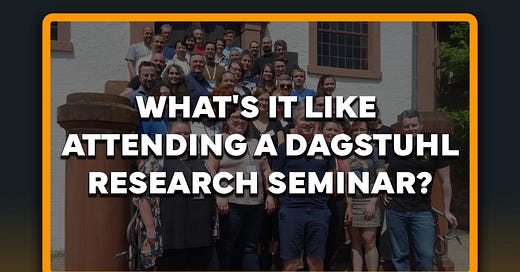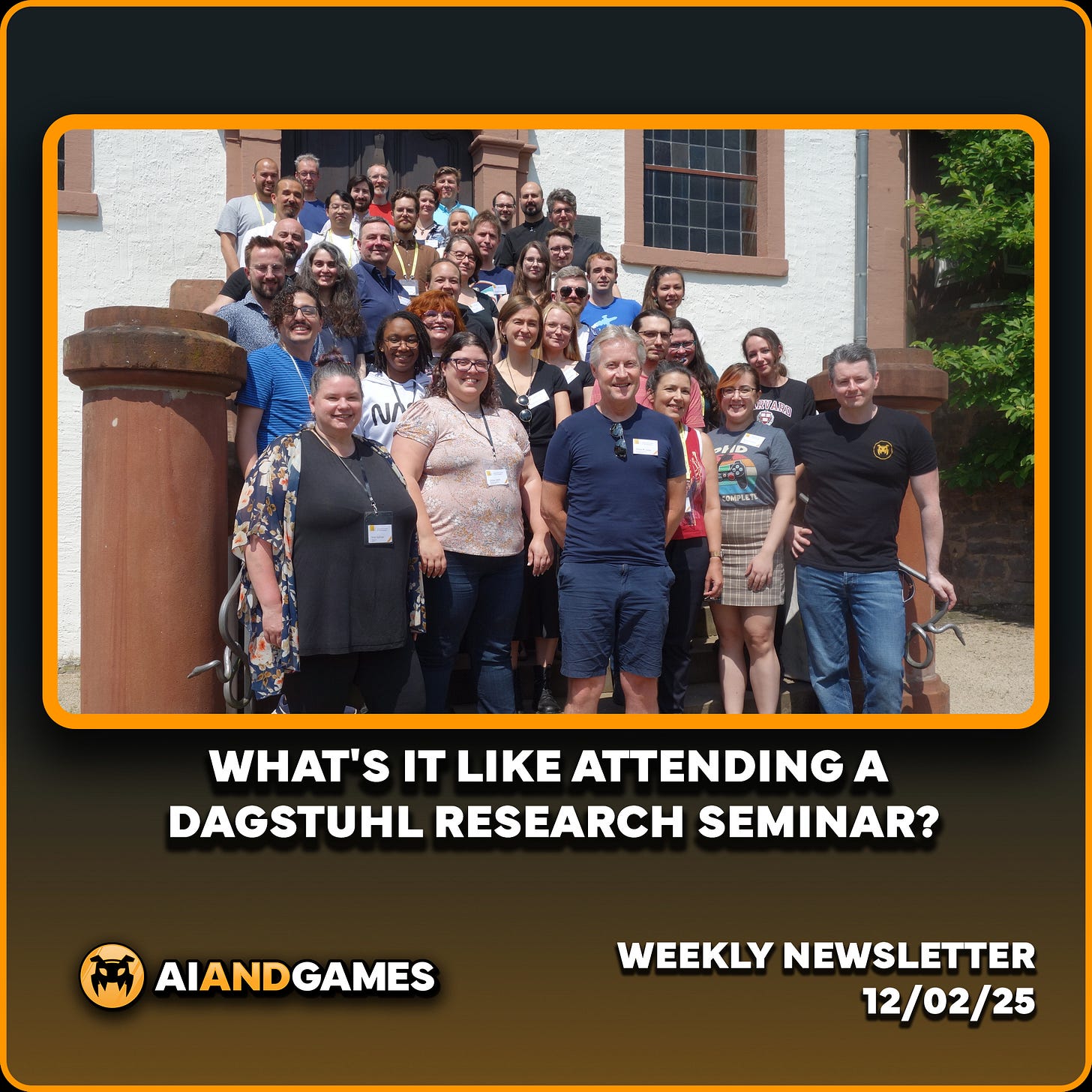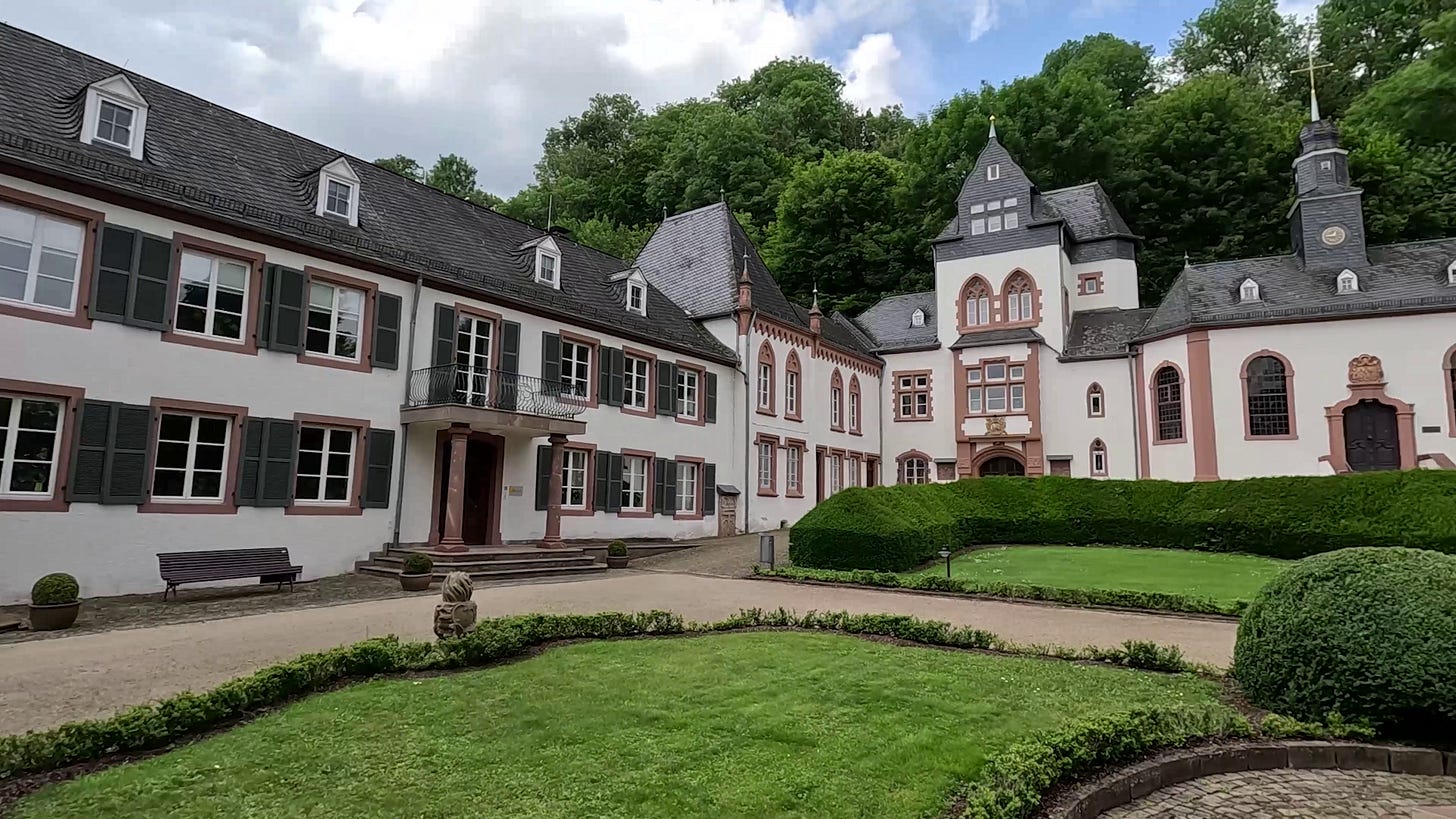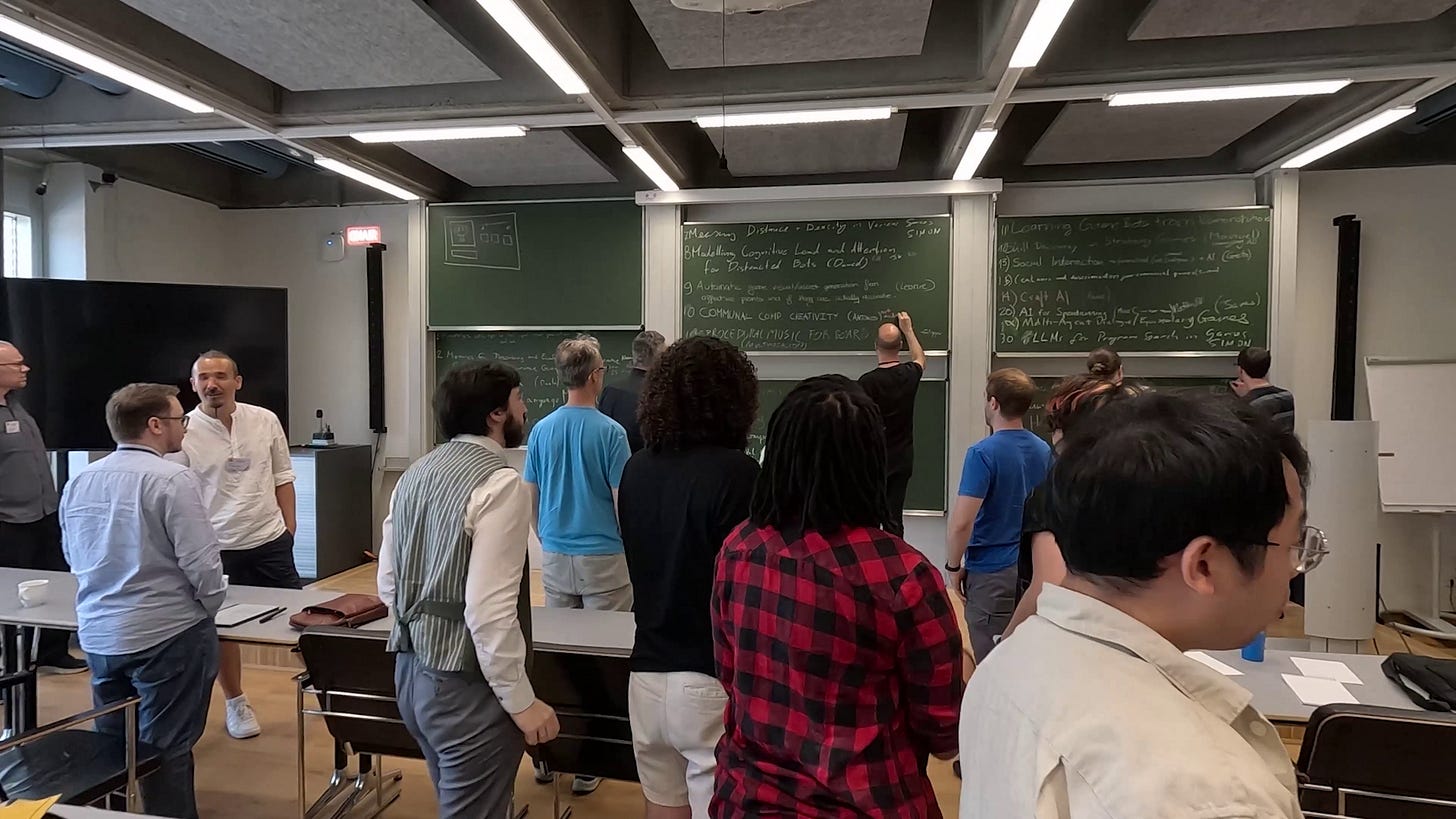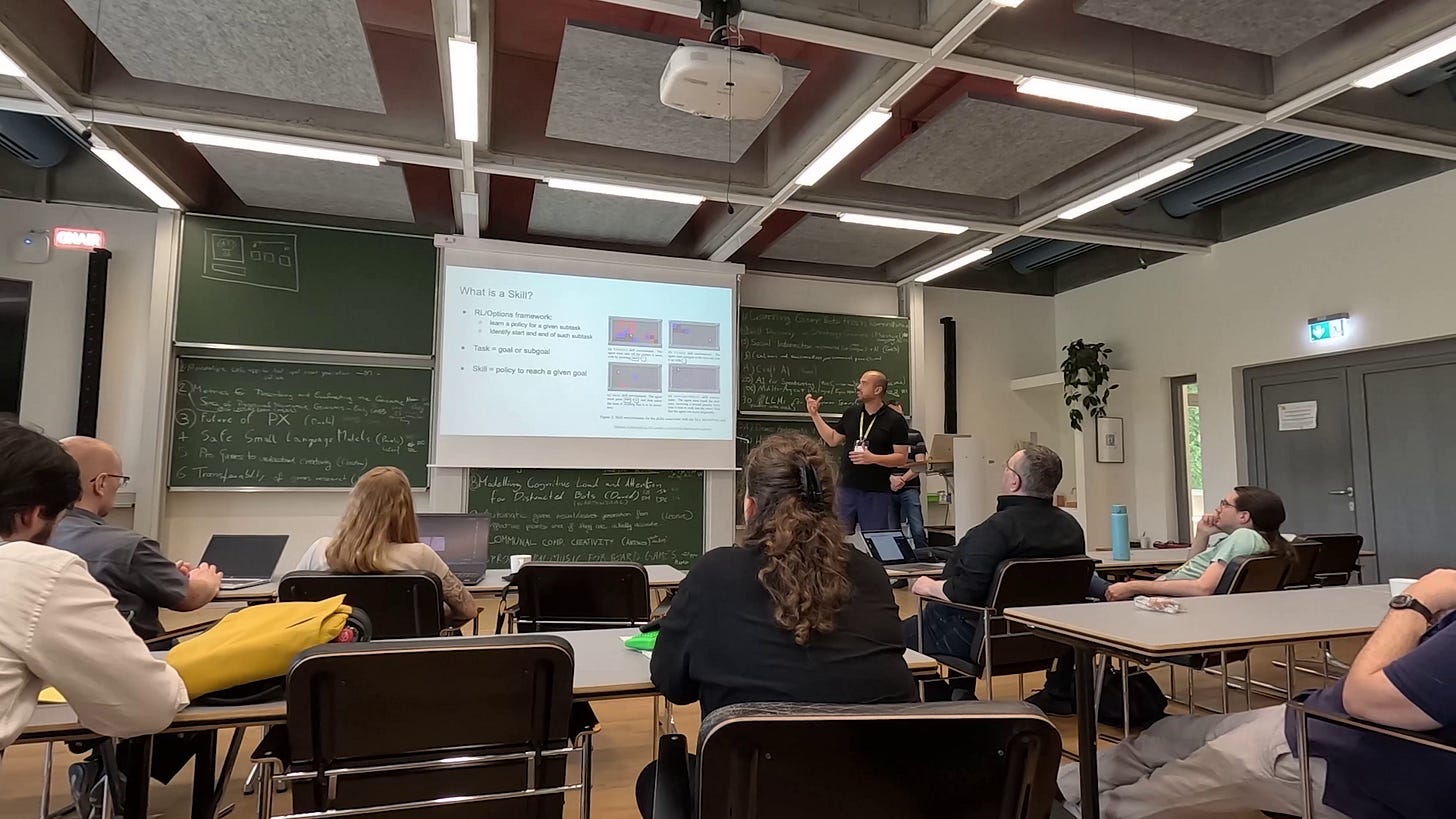A Week Discussing the Future of AI for Games at Schloss Dagstuhl | AI and Games Newsletter 12/02/25
A week talking AI for games in the German countryside (in 2024).
The AI and Games Newsletter brings concise and informative discussion on artificial intelligence for video games each and every week. Plus summarising all of our content released across various channels, like our YouTube videos and in-person events like the AI and Games Conference.
You can subscribe to and support AI and Games on Substack, with weekly editions appearing in your inbox. The newsletter is also shared with our audience on LinkedIn. If you’d like to sponsor this newsletter, please visit our sponsorship enquiries page.
Hello all and welcome back to the latest issue of the
Newsletter. I figured after coming back with a big and meaty topic a fortnight ago with the UK copyright consultation (link below if you missed it), let’s perhaps cover something a little different, and actually long overdue!Last summer I was fortunate to be touring around a whole bunch of games industry events more or less back-to-back, with invited talks at the AI and Games Summer School in Malta and the Develop Conference in the UK just a week or two apart from one another. But in between, I attended a research seminar at Schloss Dagstuhl: Leibniz Centre for Informatics exploring potential applications of AI in game development. So I’m going to recount the experience, and we even have a video that details a little of what it’s like to be at the event.
But of course before all that, let’s hit the announcements, the news and more!
Follow AI and Games on: BlueSky | YouTube | LinkedIn | TikTok
Announcements
A quick round-up of announcements all things AI and Games related…
We have two more videos published on the new AI and Games Conference YouTube channel!
Sam Devlin from Microsoft Research shares his experiences in training machine learning for game AI. What works, what doesn’t, and how best to adopt these technologies into existing practice.
Laurent Couvidou of Build a Rocket Boy discusses his experiences in Agent Tethering, the process of ensuring a character stays in their required area of the game map. Not as easy as you’d think!
Don’t forget that Game AI Uncovered Vol 3 is on sale now! Use discount code DIS20 for 20% at checkout at the publisher Routledge’s website but that discount code runs out at the end of the month! You can also buy it on Amazon.
The 2025 AI and Games Summer School early bird tickets are available until March 1st.
AI (and Games) in the News
A quick round-up of relevant AI topics in the games industry…
“Artificial Intelligence is an Oxymoron” says Take-Two CEO
Strauss Zelnick had plenty to say on the future of AI as part of game development. As part of a larger interview over at GamesIndustry.biz, Zelnick had this to say about AI’s role in the industry:
Artificial intelligence is an oxymoron, there's no such thing. Machine learning, machines don't learn. Those are convenient ways to explain to human beings what looks like magic. The bottom line is that these are digital tools and we've used digital tools forever. I have no doubt that what is considered AI today will help make our business more efficient and help us do better work, but it won't reduce employment.
To the contrary, the history of digital technology is that technology increases employment, increases productivity, increases GDP and I think that's what's going to happen with AI. I think the video game business will probably be on the leading, if not bleeding, edge of using AI.
But in terms of the guardrails, if you mean, you know, not infringing on other people's intellectual property by, you know, poaching their LLMs, yeah, we're not going to do that. Moreover, if we did, we couldn't protect that, we wouldn't be able to protect our own IP. So of course, we're mindful of what technology we use to make sure that it respects others' intellectual property and allows us to protect our own. Apart from that, I really can't think of any new guardrails that need to be implemented.
Well, there’s a lot for me to unpack there. Time to put on my old academic hat and grade this essay:
Points docked from the get go for a poor argument. Yes artificial intelligence can be considered an oxymoron, but it’s a good oxymoron!
For context: ‘artificial’ is the adjective that helps contextualise the noun ‘intelligence’. People place far too much emphasis on the ‘intelligence’ in the term, rather than ‘artificial’. It’s an artifice designed to evoke intelligent traits. Treat it as such.
Yes, correct, machine’s don’t learn. Machine Learning systems simply become ‘less bad’ at what it is doing over time. Points awarded.
They are indeed digital tools, and we have used digital tools forever.
That said, points lost because he fails to acknowledge the vast number of existing AI tools.
Citation needed for technology increasing employment/productivity/GDP.
Also, **stares at Web3**
Video games are often at the bleeding edge of AI. But games take half a decade to make! Perhaps citing development times of your own projects (say, GTA6) would help here.
The argument on protecting IP around generative models is pretty good. Though the point that we don’t need further guardrails is horribly naïve.
A lot of bluster with a lack of sufficient evidence to back it up: C+.
Zelnick, see me after class to discuss your lack of citations.
A Breakdown of Nvidia’s DLSS 4
After I detailed much of the previous versions of the technology in some YouTube videos, James Archer over at RockPaperShotgun gives a nice overview of the technology and what it all means. Perhaps someday I’ll make another video on the topic!
Harrison Ford: “You don’t need artificial intelligence to steal my soul.”
Even Dr Jones has something to say about the current climate. In a recent interview with the Wall Street Journal, Harrison Ford discussed the use of AI technology as part of the creative process - be it de-aging him in Indiana Jones and the Dial of Destiny, to hulking him out in the upcoming Captain America: Brave New World - that it’s still easier to achieve creative vision without going the route of using AI for everything. He specifically mentions Troy Baker’s rendition of his voice in the recent Indiana Jones and The Great Circle by MachineGames - voicework that has largely been celebrated, even if I honestly found it a little flat.
Layoffs at Unity (Again) Affect Development of AI Tools (Again)
Word broke on Monday that layoffs have occurred across the board at engine creators Unity. A recurring problem with the technology firm as they continue to grapple with how to make their enterprise profitable while annoying as many customers as possible. In amongst the layoffs came news courtesy of the Unity forums that the entire team behind the Behaviour package for Unity has been let go. For those unaware, ‘Behaviour’ is a visual scripting tool built by Unity that is more or less their version of Behaviour Trees - a common game AI tool that has been in Unreal Engine for over a decade.
Naturally this is a disappointing for all involved, and I wish them all the best. But it’s worth highlighting that this is the third time that Unity has started developing an AI feature for their engine, only to subsequently shutter it or downsize their efforts. Back in 2018 Unity announced their AI Planner, and was shuttered in 2020 - never leaving preview - plus the ML Agents toolkit has had only one update since 2022 which transferred the runtime inference to Unity’s ‘Sentis’ engine. With the bulk of the work now being done by the ML Agents community thanks to them open-sourcing it.
It speaks to Unity’s recurring problem of a lack of commitment towards stabilising the engine and building the features needed, and continues to fall behind Unreal Engine whose suite of AI tools continues to mature.
Attending Dagstuhl Seminar 24261: Computational Creativity for Game Development
So yeah this week let’s talk about something rather fun. Last summer, in only two days after returning from the AI and Games Summer School which I reported on at the time, I flew out to Schloss Dagstuhl in Germany for a research seminar on ‘computational creativity for game development’.
I actually vlogged the whole experience, and sadly it’s been on my to-do list for over six months as my workload piled up over 2024. So now with the Kickstarter funded (late pledges still active btw), and 2024’s conference effectively wrapped up, I figured I’d dust off the footage and get together both the video and some words on what it’s like to attend an event like this. Let’s do it!
About the Event
Schloss Dagstuhl: Leibniz Centre for Informatics is an institute dedicated to hosting research seminars for fields of computer science. Seminars are pitched for the venue to approve, and if so they they run for around a week, with guests invited to arrive on the Sunday, with work in earnest through Monday until Friday lunchtime. In each instance, the seminar organisers who pitched the event curate a list of guests to attend who can provide some perspective on the subject matter.
Seminar 24261, Computational Creativity for Game Development, was the latest in a series of events at Dagstuhl since 2012 that explore the works of AI in games. I’ve been fortunate to be invited to several of these events, and they’re really a highlight of the working year. It’s quite exciting to spent time discussing ideas and even rapidly prototyping some of these projects while at the venue; largely disconnected from the outside world and existing work commitments.
Speaking of, the venue itself is a renovated German castle (yup, castle), that now houses a number of work rooms, lodgings, plus an extension with a lecture hall and library. It’s based near the small town of Wadern in south-west Germany, close to the French and Luxembourg borders, and is quite disconnected from the bustling cities you would expect research centres to be based in. As such, it promotes a sense of isolation from the wider world, but also community with your fellow attendees - given they’re literally the only other people you will engage with for the coming days.
Discussing the Future of AI for Games
As discussed the game AI seminars have been running since 2012, and in each instance the ‘theme’ of the event shifts slightly. Since the previous event in 2022, the big change in the field is of course the boom in generative AI. Now the thing is that for us, this technology is well established, and critically it’s also not great in a lot of use cases - something that the rest of the world is now learning. So this was the real guiding point for the week, as we discussed how can this technology be used in more meaningful ways?
To quote the introduction to the report from the session, published in December 2024:
Despite the sometimes astonishing products of such creative artificial intelligence, the results are usually lacking in meaning. While DALL-E and Midjourney produce images that seem impressive, upon further inspection they contain many mistakes which humans would avoid. While ChatGPT can generate human-sounding text in a conversation, it often produces utter nonsense, and cannot write an original coherent story. And, as our own explorations of such techniques during Dagstuhl Seminar 22251 showed, GANs may produce computer game content which looks reasonable at first glance, but is ultimately neither functional nor playable.
While the product of creative artificial intelligence can often be used as a strong basis for humans to build upon, and may as such speed up the creative process, human intelligence and human creativity are almost always a necessary ingredient of the creative process. Moreover, the more relevant the meaning, purpose, and functionality of the product are, the less the creative process benefits from the involvement of artificial intelligence.
Game design and implementation are tasks which require a high amount of creativity, and which must lead to products which require a high amount of fine-tuned functionality. For example, a game “level” should not only look appealing, it should also be playable and it should be interesting to play. These are not features which can be acquired simply by “training on big data”, which is what most developments in modern artificial intelligence are based on.
The goal of this Dagstuhl Seminar is to investigate to what extent modern artificial intelligence techniques can produce meaningful and functional game content, and what changes to or extensions of these techniques can improve this AI-driven creative process.
Now critically, the aim is not to ‘solve’ these issues, but rather inspire meaningful conversations around the subject that can lead to future research, be it in academia or within business. The role of Dagstuhl as a venue is to provide the space for these types of conversations and potential collaborations to emerge without much distraction from the outside world. Plus the seminar’s attendees are often visiting from a variety of institutions around the world and it’s the arguably the one time that this specific group of people will get together to have this kind of long-form nuanced conversation.
Breaking into Workgroups
The process that this series of games-focussed seminars have operated on is typically the idea of workgroups. On the first day after the seminar has officially started - with the remit re-affirmed and everyone introducing themselves - everyone is invited to pitch topics that could be the focus of a working group. Every day throughout the week groups are formed and work is conducted, with the proviso that notes are taken and that a summary can be shared with the group. This is an important aspect given new groups often emerge from previous ones or new people may join an existing group. Plus, as mentioned there is an end report in which we summarise these conversations for ourselves and others to be able to refer to in future works.
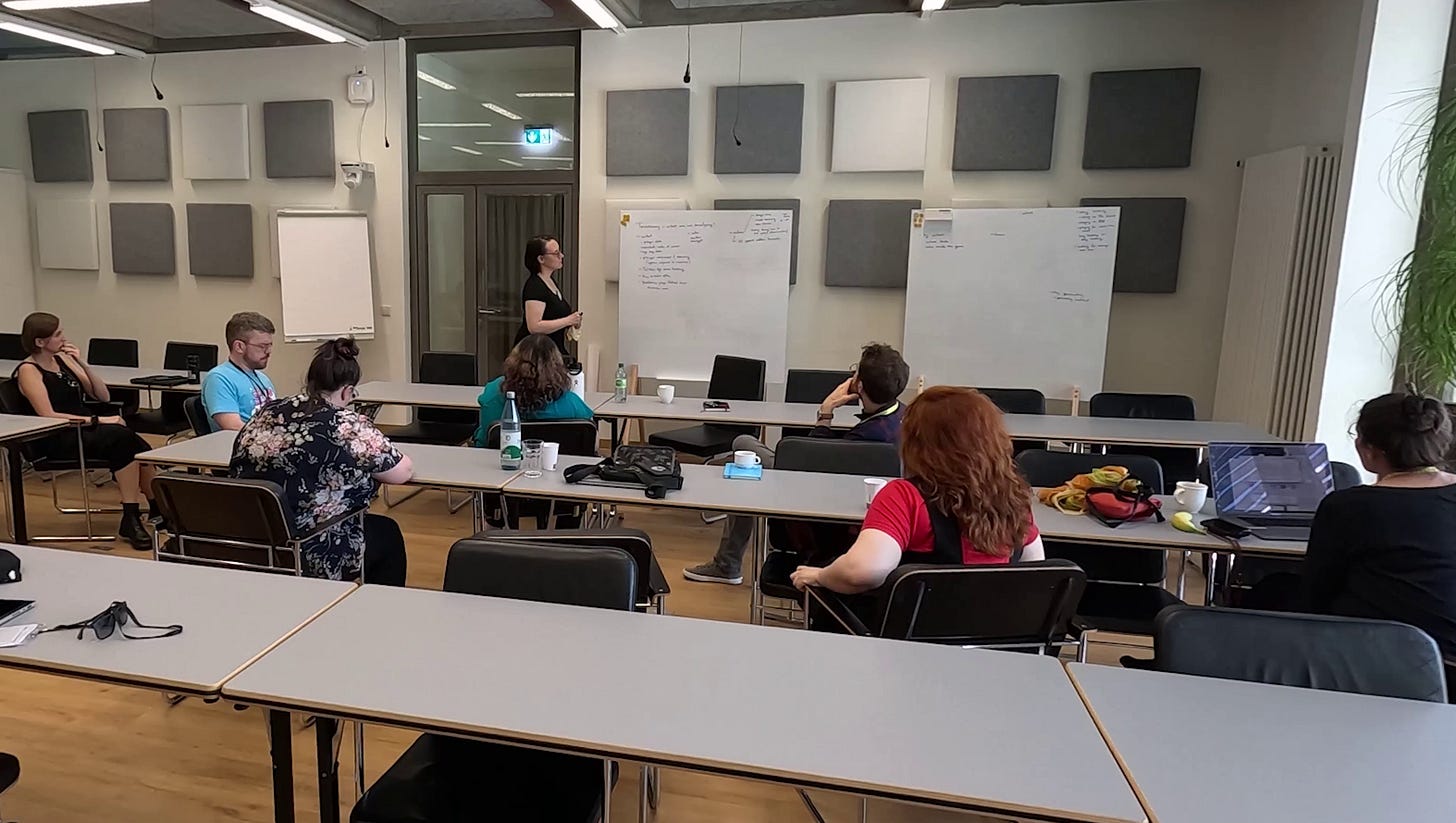
The full report gives a breakdown of the discussions of more than 20 workgroups that took place throughout the week. But for now I’ll quick summarise the groups I was involved in, and what we were exploring:
Evaluating the Generative Space of Procedural Narrative Generators:
When we consider AI systems for building narratives in games (be it with LLMs or otherwise), how do we ensure meaningful and good stories? In this group we discussed the idea of how to build architectures that enable narrative systems to generate stories that are guaranteed to adhere to a predefined level of quality while also ensuring sufficient variety. This moves us into the realm of understanding the ‘generative space’ of a system (known within our community as ‘expressive range analysis’): the range of all possible outputs measured against some user-relevant metrics.
Critically, we discussed how building these systems could be achieved with backend systems that rely on more traditional story generation methods which provide greater agency and control to human designers. Plus it then lead to a conversation of the types of metrics used to assess the generative space of these systems, and how this could be used by narrative designers, programmers, and even player themselves to understand what the system is generating, and one single playthrough reflects the broader outputs of the system.Generative Space Analysis for Procedural Narrative Generation:
A follow-up workgroup that burrowed down into the closing talking points of the previous group, what metrics could you use to define narrative quality? To explore this we looked at how to quantify the play traces of a game’s narrative by recording important stats or events over time. From this we explored the idea of narrative ‘shapes’ - recurring patterns in these traces - that would occur as a result of common story beats and tropes that occur in storytelling.AI for Romantic Comedies (Part II): A continuation of an idea from the Dagstuhl seminar in 2022, in how can you use AI as a mechanism to procedurally generate romantic comedy narratives for games. We had discussed this previously given we found it an interesting challenge due both to the subjective nature of comedy, but how romantic comedies are about crafting contrived scenarios that can equally prove funny while encouraging romantic connection. It’s a challenge of both constraint modelling and narrative design. Having had several sessions on narrative generation, this led to a group of us returning to this idea in more detail, and even building a prototype of a farce that occurs during a double date at a restaurant.
Communal Computational Creativity: Arguably the session that sought to address the elephant in the room - the often destructive and ill-thought applications of generative models (i.e. about 99% of the stuff you see on the internet and in businesses). How can we utilise these systems in ways that can support and reinforce creative processes without proving detrimental? Is this even possible? What are the ramifications of these technologies in education, and in the crafting of future skilled workers and artists. Perhaps a conversation best suited for when the wine was poured in the evening, or not…
Of course these are just the sessions I was involved in, and there was lot more that explored a variety of ideas. Some of which hitting on that core generative AI theme, sometimes not. There’s no set rule on exactly what is discussed, but I’d recommend checking out the final report I link to at the end of this issue with the summaries of all the groups including AI for speed running games, generative AI in arts and crafts, the transferability of game AI research to other domains, the impact of AI on user experience (UX) research and training language models to learn to write programs to ‘solve’ playing games or even design new ones on the fly.
Read the Findings Yourself
If you’re interested in find out more about the event, visit the page dedicated to the seminar on the Dagstuhl website. Plus, it links to the final report that was published back in December of 2024 which summarised all of the workgroups, their discussions, and findings from any preliminary work they conducted. Also be sure to catch the video at the top of the article, given I go into a lot more detail on the realities of Dagstuhl as a venue and the history of these games-related seminars.
Thanks once again to all my fellow attendees for a great week, as well as the organisers and venue for putting on the seminar. Fingers crossed I get to make the pilgrimage to Dagstuhl once again in the future.
Wrapping Up
A fun and low-key week here on the newsletter, but we’ll be back discussing the state of the industry in a fortnights time with the GDC State of the Industry Report. Join me next week for the sponsor’s update - complete with all of the stuff happening behind the scenes - and of course all of the regular news and updates.
Thanks for reading and I’ll catch you again soon.


